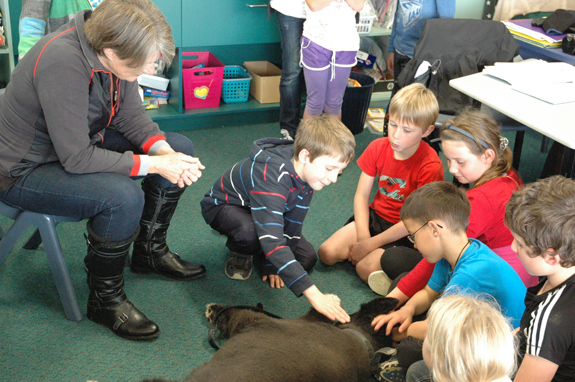With domestic violence and child abuse huge problems in our society, two Auckland grandmothers are using the ‘top dog’ message to change the way kids feel about themselves, enabling them to change the subliminal messages they give off to others, including bullies and potential abusers.
The large black dog stops barking and flops down onto the mat, rolling over to gaze up at the kids. Annie Aubrey smiles at the class. “You did that,” she tells them. “You made him quiet and happy by being calm and confident yourselves.”
The children look pleased.
Auckland grandmother Annie Aubrey is teaching the kids to be the pack leader. She says that by understanding dog psychology, children can learn to be safe around dogs and can also improve their own assertiveness.
Annie and Marj Mulholland are the creators of ‘Sam’s Dog Rules’ and they’re on a mission. Their initial idea was to teach kids dog safety (ACC figures show there are 30 dog bites a day, nationwide) but it has expanded into a wider programme of self-esteem for children. And already in 2012, together with Sam the dog, they’ve taken this message to over 5000 children at schools and preschools around the country.
The 40-minute lesson starts with dog manners, and an explanation that for a dog to feel safe, it needs to know there is a top dog. “Dogs are pack animals,” says Annie. “If there is no other top dog, then a dog will feel compelled to become top dog themselves, so it will defend not only its territory but any area around it, which is when we see the barking and the attacks.”
Annie invites one of the children to come up and greet her, look her in the eye and shake hands, explaining that dog manners are the opposite. “In dog packs, the top dog never approaches another dog,” she says. “So when you see a dog, you must not approach, look at or talk to it. It’s a really simple message – ‘no touch, no look, no talk’”.
The kids take turns to stand and allow the dog to come up and sniff them. “Once the dog has come up and sniffed you, the dog is saying ‘you are the pack leader’. At that stage it’s safe to touch and look at the dog.”
There’s no mistaking who is top dog during the lesson. Three boys whispering in the back row are kindly but firmly invited by Annie to stand and repeat the ‘no touch, no look, no talk’ message to the whole class, after which they quietly sit down.
Sam is a Keyshawn-Samoyed cross – both pedigrees bred to work with people, herding reindeer and pulling sleighs. Captivated by Sam as a puppy in a pet shop 12 years ago, Annie’s always knew he’d be an ideal dog to work with children.
Initially motivated by the number of dog bites in New Zealand, Annie soon discovered she was not just teaching the kids dog safety skills, but ways to feel powerful, and how to use this inner strength in other areas of their lives.

Both adults and children instinctively pick up on subtle changes in the energy of those around us, writes US dog whisperer Cesar Millan, in his book Cesar’s Way. Dogs will typically accept as pack leader the dog or human that projects the correct calm-assertive energy – in much the same way that we choose leaders who project a powerful energy, he says. Conversely, a bully senses the weaker energy of his victim.
“Dogs are an excellent barometer of how we’re feeling,” says Annie. So we can use dogs to reflect back to the kids how calm and assertive the kids are.”
Building on this, Annie has developed the idea of a ‘superhero’ suit. “Dogs are really drawn to the hero energy – just as kids all like superheros and heroes. So we talk about Dan Carter and Irene Van Dyke – people who exude calm magnetic assertive energy. I then pick the child who seems to have the least self-esteem and ask them to come up and meet Sam the dog. I ask the child how they would feel if their teacher was proud of them for something they had done. The whole class goes really quiet. The child will say they would feel really happy and good and brave and courageous and proud and I say – that’s what a superhero feels like and that’s how you have to feel when you’re talking to a dog.”
Annie and Marj have had really positive feedback about the kids’ ability to avert bullying – with some schools going on to use this technique to help kids address other fears.
There is no shortage of self-esteem advice available to us today, but as psychologist Deborah Plummer puts it, “self esteem is talked about and written about in great depth but for many, the ability to achieve a healthy level of self esteem seems perpetually elusive.” Just as babies have been instrumental in teaching children empathy (though the hugely successful international programme Roots of Empathy), it seems dogs might be part of the answer in teaching children about self esteem.
According to research conducted by US child psychologist Dr Robert Bierer, children who had pet dogs when they were young were more confident and had higher self-esteem. Bierer put this down to dog’s unconditional acceptance and also the sense of responsibility a child gains from contributing to a dog’s care. Annie suggests it’s also likely to be a reflection of the calm assertive energy children master early on as a result of being a dog owner.
Not all children can directly experience being dog owners, but by working with children, one small group at a time, Annie and Marj can provide an opportunity for children to practice the inner shift of being top dog and learn by watching the Sam’s behaviour.
At the end of the lesson, the children chant: “No touch, no talk, no look, put your hero suit on and be the pack leader!” Sam lies quietly on the classroom floor.





